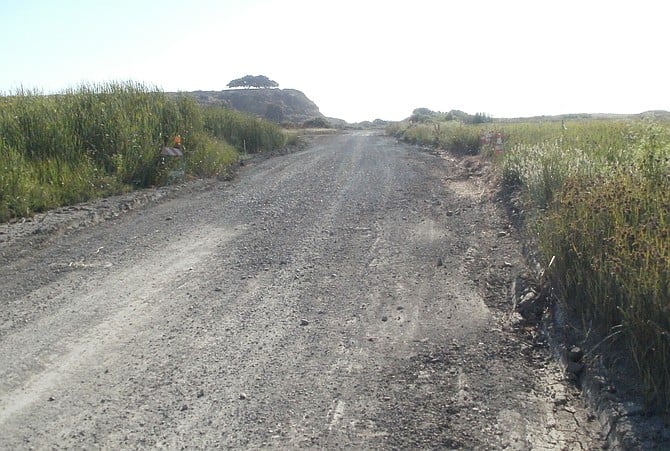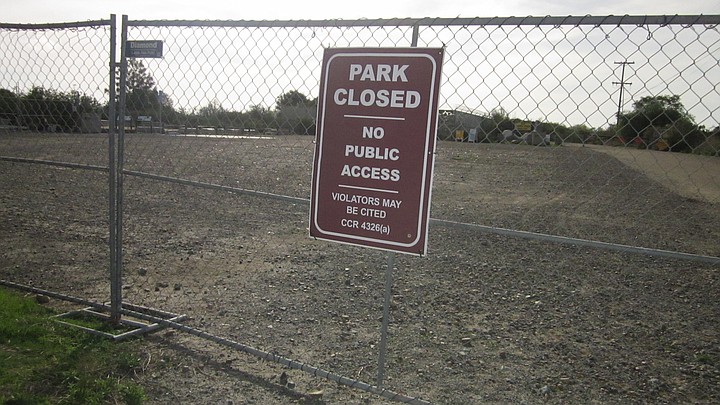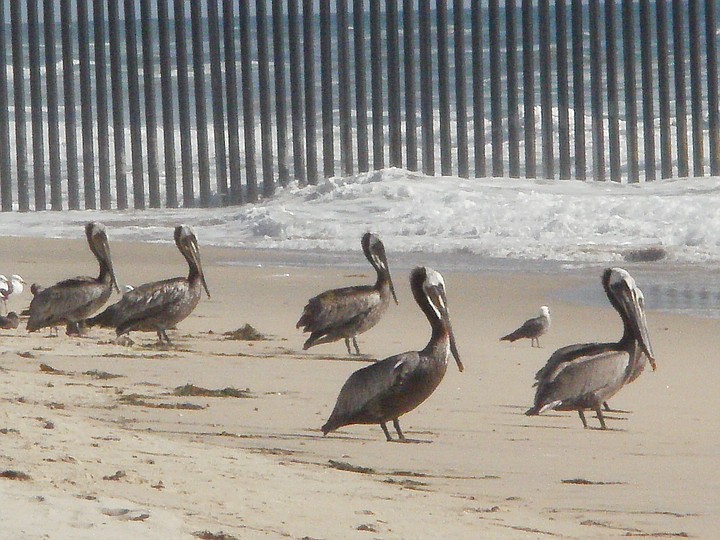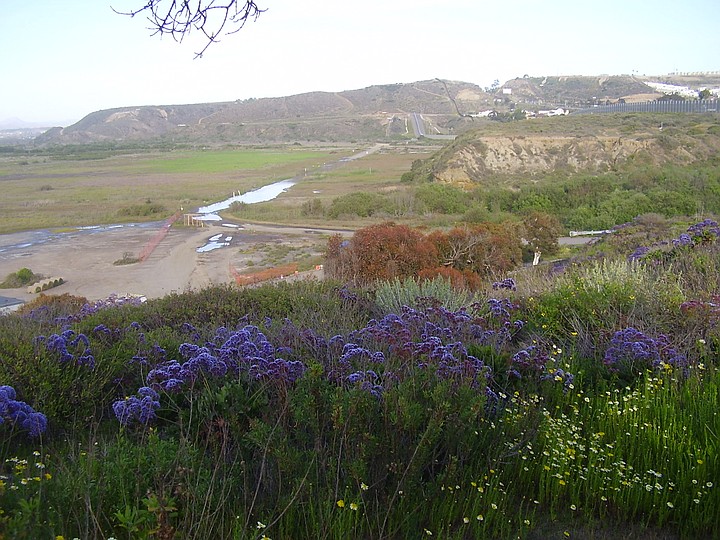 Facebook
Facebook
 X
X
 Instagram
Instagram
 TikTok
TikTok
 Youtube
Youtube

Six years after the legislature set aside $6 million for the damaged road at Border Field State Park, the road remains closed — not repaired or replaced. Instead, cyclone fencing blocks all access to the 788-acre state park, and sources say the public area on Monument Mesa is overgrown with weeds.
The park has been closed since December 2019.

No one from state parks, not reserve manager Chris Peregrin nor anyone else from the parks, has submitted a formal proposal to obtain a California Coastal Commission permit, coastal commission staff say. The commission is very interested in approving the project because it not only promotes public access generally, but it stands to improve beach access for San Ysidro, Chula Vista, Otay Mesa and other South Bay communities that have limited access to coastal resources. “It isn’t just disabled people who could benefit from the road, it’s older people, families with children, it’s events that could be held on Monument Mesa at the coast without the one and a half mile hike in,” says Coastal Program Analyst Toni Ross. “It’s the kind of project we embrace.”
Instead, Peregrin and the parks staff have spent 75 percent of the $678,000 awarded immediately in 2015 evaluating plans for a range of solutions, including a suspension bridge. State parks spokesman Jorge Moreno didn’t respond to questions about the remaining $5.3 million.
“It’s a major bummer that the park is always closed,” says Ben McCue, executive director of Outreach Outside. “I know it’s not an easy issue but it’s time state parks prioritize public access to the beach.” McCue’s nonprofit works with youth who haven’t had access to open spaces and outdoors experiences, including kids in the South Bay and Southeast San Diego – taking them hiking and mountain biking, for example.
“Border Field was a great place to take the youth we work with – it’s significant for historical, cultural, environmental and so many other ways,” he says. “It’s such a treasure and such an opportunity for the youth in our community.”

It was those communities that retired county supervisor Greg Cox was thinking about when he asked the legislature to earmark the money, obtained from a settlement with the U.S. Department of Homeland Security, for the project in 2015. As a past coastal commission chair, he was able to connect the dots quickly, engaging Toni Atkins to add it to Assembly Bill 93, which sent the $5.95 million to the state parks recreation fund earmarked for the improvements. That the road sometimes floods has long been used to close the park road for most of the year. But in 2015, with the money secured, Peregrin told me "A project of this scope can take up to five years to complete provided no unforeseen delays."
Instead, the project seems to have fallen to the bottom of the list of work to be done.
“Planning and design to establish year-round vehicular access was initiated in 2016 and has remained in the preliminary planning phase due to substantial regulatory and project cost constraints,” Moreno said in a written response. “Alternatives that avoid wetland impacts are costly, alternatives that are financially viable impact wetlands, presenting regulatory challenges and uncertainly of final approval. Alternatives that do not provide year-round vehicular access fall short of requisite public access to the park.”

But Ross says, the commission has worked to find ways to eliminate or reduce the obstacles typical to projects that cross valued wetlands. For example, mitigation to provide habitat for plants and creatures displaced by a road can be done inside the park boundaries. And the commission supports using constructions methods like berms that are not expected to last 50 years or more, reducing the scope of any climate adaptation study.
“We’d really like to see a proposal,” she said. “Interest in getting this in front of the commission for approval goes all the way to the top of commission management.”
None of those conversations have prompted the parks to turn in a written proposal, and that’s where the process of getting a permit to build begins. Without a proposal, it’s hard to seek funding.
Sources say that Peregrin has similarly implied to the commission that the U.S. Border Patrol has been an obstacle, though the agency has little say over what is done on park land – and has actually used its own resources to improve park roads.
The park’s complete closure has hurt one of the valley’s economies, horseback rides on the beach. Kelly Osborne, of Surfside Ranch, said that, with the threat of thousand-dollar fines, the perfect-for-COVID activity had to just shut down.
“We had to sell five of our horses and put down a couple with (medical) problems that we could carry when we were making money,” she said. “The state requires us to carry a million-dollar insurance policy that costs $10,000 a year and we’ve had to continue to pay the money.”
The road is closed most of the year – weekends during summer was the most likely time to find it open. But many people – and horses – entered and made the 1.5 mile hike to the park’s cornerstone, Monument Mesa. A high point of land adjacent to the beach, the mesa was the only U.S. access to Friendship Park. Volunteers crafted a garden of California native plants inside the 100-foot wide area owned by the Department of Homeland Security; on weekends, people used to gather on both sides of the border fence to visit with loved ones in Mexico under the watchful eyes of border patrol agents who facilitated the visits.
Peregrin closed Border Field in December 2019 after flooding left sediment on the road. He has cited flooding, personnel shortages, and even the presence of e.coli and enterococci bacteria in the soil near the enormous catch basins in Goat Canyon. An Imperial Beach group, Citizens for Coastal Conservancy, spent eight months trying to get a report on those bacteria from the agency under the California Public Records Act.
At the same time Peregrin simply eliminated public access, the county’s Tijuana River Valley Reserve, immediately east of Border Field, has been working diligently to increase public access to outdoor space in the valley, with the construction of a new campground, trails, and expanded ball fields and its community gardens as well as maintaining and improving trails used by horses, hikers and cyclists.
But the county park has no beach access, so that hikers and equestrians who reach the boundary with the state park are met by fencing, and often a state parks cop who turns them back.


Six years after the legislature set aside $6 million for the damaged road at Border Field State Park, the road remains closed — not repaired or replaced. Instead, cyclone fencing blocks all access to the 788-acre state park, and sources say the public area on Monument Mesa is overgrown with weeds.
The park has been closed since December 2019.

No one from state parks, not reserve manager Chris Peregrin nor anyone else from the parks, has submitted a formal proposal to obtain a California Coastal Commission permit, coastal commission staff say. The commission is very interested in approving the project because it not only promotes public access generally, but it stands to improve beach access for San Ysidro, Chula Vista, Otay Mesa and other South Bay communities that have limited access to coastal resources. “It isn’t just disabled people who could benefit from the road, it’s older people, families with children, it’s events that could be held on Monument Mesa at the coast without the one and a half mile hike in,” says Coastal Program Analyst Toni Ross. “It’s the kind of project we embrace.”
Instead, Peregrin and the parks staff have spent 75 percent of the $678,000 awarded immediately in 2015 evaluating plans for a range of solutions, including a suspension bridge. State parks spokesman Jorge Moreno didn’t respond to questions about the remaining $5.3 million.
“It’s a major bummer that the park is always closed,” says Ben McCue, executive director of Outreach Outside. “I know it’s not an easy issue but it’s time state parks prioritize public access to the beach.” McCue’s nonprofit works with youth who haven’t had access to open spaces and outdoors experiences, including kids in the South Bay and Southeast San Diego – taking them hiking and mountain biking, for example.
“Border Field was a great place to take the youth we work with – it’s significant for historical, cultural, environmental and so many other ways,” he says. “It’s such a treasure and such an opportunity for the youth in our community.”

It was those communities that retired county supervisor Greg Cox was thinking about when he asked the legislature to earmark the money, obtained from a settlement with the U.S. Department of Homeland Security, for the project in 2015. As a past coastal commission chair, he was able to connect the dots quickly, engaging Toni Atkins to add it to Assembly Bill 93, which sent the $5.95 million to the state parks recreation fund earmarked for the improvements. That the road sometimes floods has long been used to close the park road for most of the year. But in 2015, with the money secured, Peregrin told me "A project of this scope can take up to five years to complete provided no unforeseen delays."
Instead, the project seems to have fallen to the bottom of the list of work to be done.
“Planning and design to establish year-round vehicular access was initiated in 2016 and has remained in the preliminary planning phase due to substantial regulatory and project cost constraints,” Moreno said in a written response. “Alternatives that avoid wetland impacts are costly, alternatives that are financially viable impact wetlands, presenting regulatory challenges and uncertainly of final approval. Alternatives that do not provide year-round vehicular access fall short of requisite public access to the park.”

But Ross says, the commission has worked to find ways to eliminate or reduce the obstacles typical to projects that cross valued wetlands. For example, mitigation to provide habitat for plants and creatures displaced by a road can be done inside the park boundaries. And the commission supports using constructions methods like berms that are not expected to last 50 years or more, reducing the scope of any climate adaptation study.
“We’d really like to see a proposal,” she said. “Interest in getting this in front of the commission for approval goes all the way to the top of commission management.”
None of those conversations have prompted the parks to turn in a written proposal, and that’s where the process of getting a permit to build begins. Without a proposal, it’s hard to seek funding.
Sources say that Peregrin has similarly implied to the commission that the U.S. Border Patrol has been an obstacle, though the agency has little say over what is done on park land – and has actually used its own resources to improve park roads.
The park’s complete closure has hurt one of the valley’s economies, horseback rides on the beach. Kelly Osborne, of Surfside Ranch, said that, with the threat of thousand-dollar fines, the perfect-for-COVID activity had to just shut down.
“We had to sell five of our horses and put down a couple with (medical) problems that we could carry when we were making money,” she said. “The state requires us to carry a million-dollar insurance policy that costs $10,000 a year and we’ve had to continue to pay the money.”
The road is closed most of the year – weekends during summer was the most likely time to find it open. But many people – and horses – entered and made the 1.5 mile hike to the park’s cornerstone, Monument Mesa. A high point of land adjacent to the beach, the mesa was the only U.S. access to Friendship Park. Volunteers crafted a garden of California native plants inside the 100-foot wide area owned by the Department of Homeland Security; on weekends, people used to gather on both sides of the border fence to visit with loved ones in Mexico under the watchful eyes of border patrol agents who facilitated the visits.
Peregrin closed Border Field in December 2019 after flooding left sediment on the road. He has cited flooding, personnel shortages, and even the presence of e.coli and enterococci bacteria in the soil near the enormous catch basins in Goat Canyon. An Imperial Beach group, Citizens for Coastal Conservancy, spent eight months trying to get a report on those bacteria from the agency under the California Public Records Act.
At the same time Peregrin simply eliminated public access, the county’s Tijuana River Valley Reserve, immediately east of Border Field, has been working diligently to increase public access to outdoor space in the valley, with the construction of a new campground, trails, and expanded ball fields and its community gardens as well as maintaining and improving trails used by horses, hikers and cyclists.
But the county park has no beach access, so that hikers and equestrians who reach the boundary with the state park are met by fencing, and often a state parks cop who turns them back.
Comments